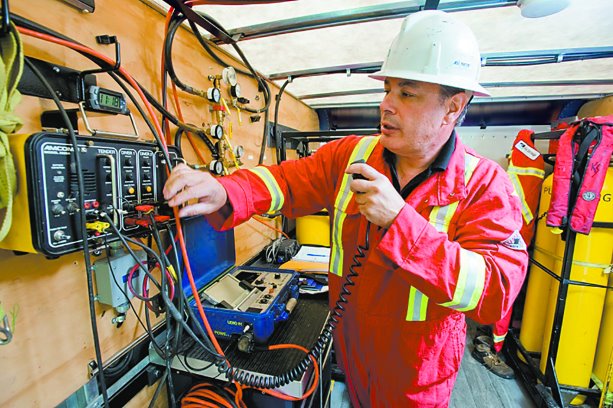It’s one of the most hazardous jobs in construction where a simple mistake is usually fatal and where working in the dark with limited mobility is just another day at the office.
Commercial divers aren’t on every job site but when they are, they take safety seriously because of the inherent risks: there are no margins for error working 140 feet down in murky waters.
While recreational divers are usually presented in exotic locations diving on colourful coral reefs and sunken wrecks in crystal clear, sun dappled waters, there’s no glamour for a commercial diver who ply their trade year round.
"The only glamour is in the bar telling tall tales," laughs Doug Elsey of the Canadian Association of Diving Contractors (CADC) which represent the industry’s interests with government regulators. The weather is a bigger factor on the water where rough seas, high winds and cold temperatures make things miserable.
"Sometimes being in the water is the warmest place to be," says Aaron Griffin, program coordinator of the underwater skills program at Seneca College in Toronto.
"Especially in the winter when the wind is coming at you vertically on the deck."
It’s tough work mentally and physically and Seneca’s training program graduates about 33 students every nine months from an intake of 48.
Commercial diving is different to recreational diving. For one, the equipment is much more sophisticated and there’s a lot more back up and support on hand.
Griffin says the most common set up is with surface supplied air running through a hose connected to a pump on the surface. The diver is usually encased in a dry-suit and if they’re working in polluted waters like Toronto or Hamilton harbour, they’ll be wearing a sealed helmet known as a hat.
There’s also a communications wire running with the hose and both are connected to an umbilical — the strength member — which has a 900 kilogram load capacity in the event a diver has to be pulled to the surface. The communications wire allows for two way voice conversations.
"The regulations in Ontario also require you to have one standby diver, one tender, that’s someone to hold and keep the hose moving as needed, and a diver supervisor on deck at all times," Griffin says.
Working conditions aren’t optimal. It’s dark, cold and there are always underwater hazards to contend with.
"You get used to working in the dark, even with the lights," says Griffin. "I think I can fix my car better in the dark than I can with the lights on."
The only rules which can’t be bent in working underwater are the laws of nature. Working with air at depths past 30 feet or so means nitrogen is absorbed into the bloodstream. The more time at that depth, the more nitrogen accumulates. If the diver surfaces without clearing the nitrogen from their system they will get "bent" or decompression sickness.
The maximum dive depth is 165 ft. for surface supplied air.
"For a profile like that, we’d run decompression, starting with some oxygen, with stops at 60, 50, 40, 30 ft. for a total of 21 minutes, followed by 54 minutes in the (Hyperbaric decompression) chamber," says Griffin.
"We have to have a chamber on board for commercial dives and really you go in there and read a magazine and just wait until you’ve done your time."
Safety is everything, says Elsey, and that’s why the industry continues to press all jurisdictions to adopt CSA guidelines as a minimum.
"Right now some pick a little of this and a little of that," he says. "We want it all to be the same."
While divers in Ontario are represented by the United Brotherhood of Carpenters, it’s not a high paying job these days.
"When I started in the 1960s it was $25 an hour and it’s now between $25 and $35," says Elsey, noting there’s no confirmed number of registered commercial divers in Canada but he estimates there are probably around 1,200 to 3,000.
Still, he says, despite the downturn in the oil sector which has seen some diving jobs dry up, there’s a coming boom in infrastructure investment in Canada which should see more demand for divers working on bridge pilings and in other areas over inland waterways.
That’s welcome news for Garth Hiebert, a Seneca grad and co-owner of Dominion Divers in Winnipeg, who says commercial diving can be a grind and up and down, pun intended.
"One day after another on some jobs doing the same thing," he says.
Dominion was the diving contractor on three Ontario Ministry of Transportation contracts in Northern Ontario this past year, working on the Noden Causeway at Rainy Lake. There were 1,120 steel support pilings which had corroded over the 60 year lifespan. Each piling had to be wrapped in fiberglass and then the space filled with an epoxy grout to block out oxygen.
Dominion has up to 28 divers in peak periods but it tends to be seasonal, Hiebert says, and sensitive to the economy.
"With oil down, a lot of offshore divers are coming in land looking for work but it’s not the same, in some ways it’s harder and the conditions are harsher," he says.
"But that’s the industry. Back in 2003-2004, U.S. dive companies were coming up here and hiring entire classes of graduates to work down there repairing infrastructure after a big hurricane."
While there isn’t much glamour on the job there are memorable moments: "We had one job in Hawaii cleaning dolphin pens. Nice place but the job was horrible. We ended up training their people to do it. Personally, I liked diving in Churchill, Man. The waters were full of beluga whales, it was amazing."

1/3
Photo:
2/3
Photo:



Recent Comments
comments for this post are closed